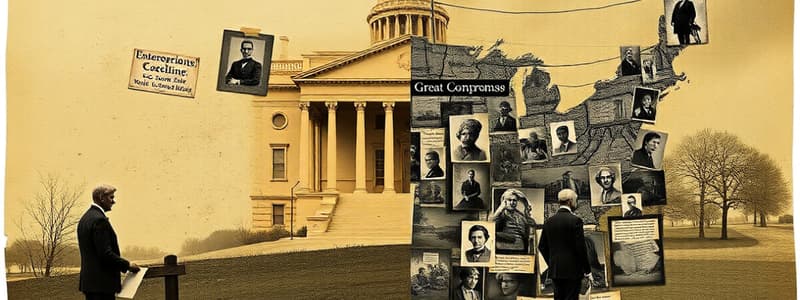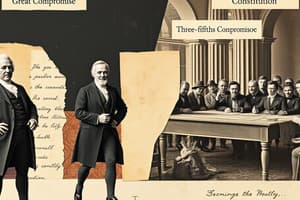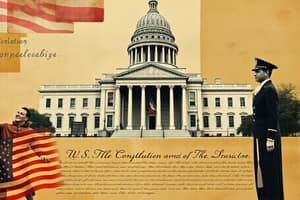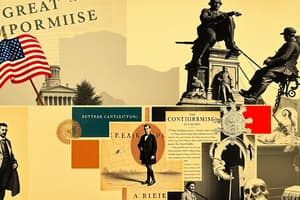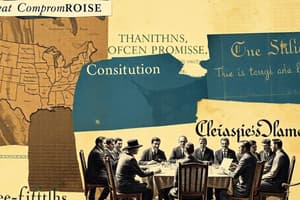Podcast
Questions and Answers
What was the main purpose of the Great Compromise?
What was the main purpose of the Great Compromise?
- To create equal representation for all states
- To establish the Bill of Rights
- To resolve disagreements on representation in Congress (correct)
- To define the three branches of government
How did the Three-Fifths Compromise address the representation conflict?
How did the Three-Fifths Compromise address the representation conflict?
- By counting enslaved individuals as two-fifths of a person
- By counting three out of every five enslaved persons as individuals (correct)
- By counting every enslaved person as one whole person
- By allowing Southern states to have more representatives without limitations
What is one major function of the legislative branch according to the division of powers?
What is one major function of the legislative branch according to the division of powers?
- To interpret laws
- To make laws (correct)
- To enforce laws
- To propose amendments
What does the amendment process of the Constitution allow?
What does the amendment process of the Constitution allow?
Why was the Bill of Rights added to the Constitution?
Why was the Bill of Rights added to the Constitution?
Which branch of government is responsible for enforcing laws?
Which branch of government is responsible for enforcing laws?
What is the role of the judicial branch in the U.S. government system?
What is the role of the judicial branch in the U.S. government system?
What aspect of government does the separation of powers aim to protect?
What aspect of government does the separation of powers aim to protect?
Flashcards
The Great Compromise
The Great Compromise
A proposal that created a bicameral legislature with equal and proportional representation.
Bicameral Legislature
Bicameral Legislature
A legislative system with two houses: the Senate and the House of Representatives.
3/5 Compromise
3/5 Compromise
Agreement that counted enslaved persons as three-fifths for representation and tax purposes.
Three Branches of Government
Three Branches of Government
Signup and view all the flashcards
Legislative Branch
Legislative Branch
Signup and view all the flashcards
Amendment Process
Amendment Process
Signup and view all the flashcards
Bill of Rights
Bill of Rights
Signup and view all the flashcards
Separation of Powers
Separation of Powers
Signup and view all the flashcards
Study Notes
The Great Compromise
- The Constitutional Convention committee, led by Roger Sherman, resolved disagreements by creating a compromise.
- This compromise addressed representation in the legislative branch.
- Each state would have two senators in the Senate, regardless of population.
- The House of Representatives' representation would be based on the state's population.
The Three-Fifths Compromise
- Delegates from the North and South had differing views on how to count enslaved populations for representation in Congress.
- The Three-Fifths Compromise's solution determined one enslaved person would count as three-fifths of a free person for representation purposes.
- This compromise also impacted taxation, tying it to the state's population with this calculation.
Branches of Government
- Legislative: Congress establishes the legislative branch; consisting of the Senate and House of Representatives.
- Executive: This branch is led by the President, Vice President, cabinet, and other federal agencies.
- Judicial: The supreme court and other courts form the judicial branch.
Separation of Powers
- The separation of powers established by the U.S. Constitution prevents any one branch from becoming too powerful.
- The branches work together to ensure efficient government and protection of citizens' rights.
Amendment Process
- The Constitution is designed to be adaptable to changing times and challenges.
- The amendment process allows for changes to the Constitution as needed, reflecting society's advancements.
Bill of Rights
- The Bill of Rights is the first ten amendments to the Constitution, added to protect citizens' rights.
- Antifederalists advocated for these additional protections.
- The Bill of Rights reflects the ongoing importance of the political process.
Studying That Suits You
Use AI to generate personalized quizzes and flashcards to suit your learning preferences.
